Management Information Systems: Coca-Cola ERP Report
VerifiedAdded on 2020/05/28
|13
|2939
|124
Report
AI Summary
This report provides an in-depth analysis of Enterprise Resource Planning (ERP) systems, specifically focusing on their implementation and impact within The Coca-Cola Company. The report begins with definitions and an introduction to ERP systems, highlighting their role in streamlining business processes, integrating various functional information systems, and providing competitive advantages. It then delves into Coca-Cola's adoption of the SAP ERP system, detailing its uses in financial consolidation, planning, supply chain management, and customer relationship management. The report examines the strategic advantages gained by Coca-Cola, including improved internal and external collaboration, streamlined supply chain management, increased sales and customer base, minimized production costs, and better decision-making. The analysis also considers the challenges and the importance of maintaining system stability and brand protection in the face of evolving technology and potential threats. The report concludes with recommendations based on the assessment of the system's strengths and weaknesses.
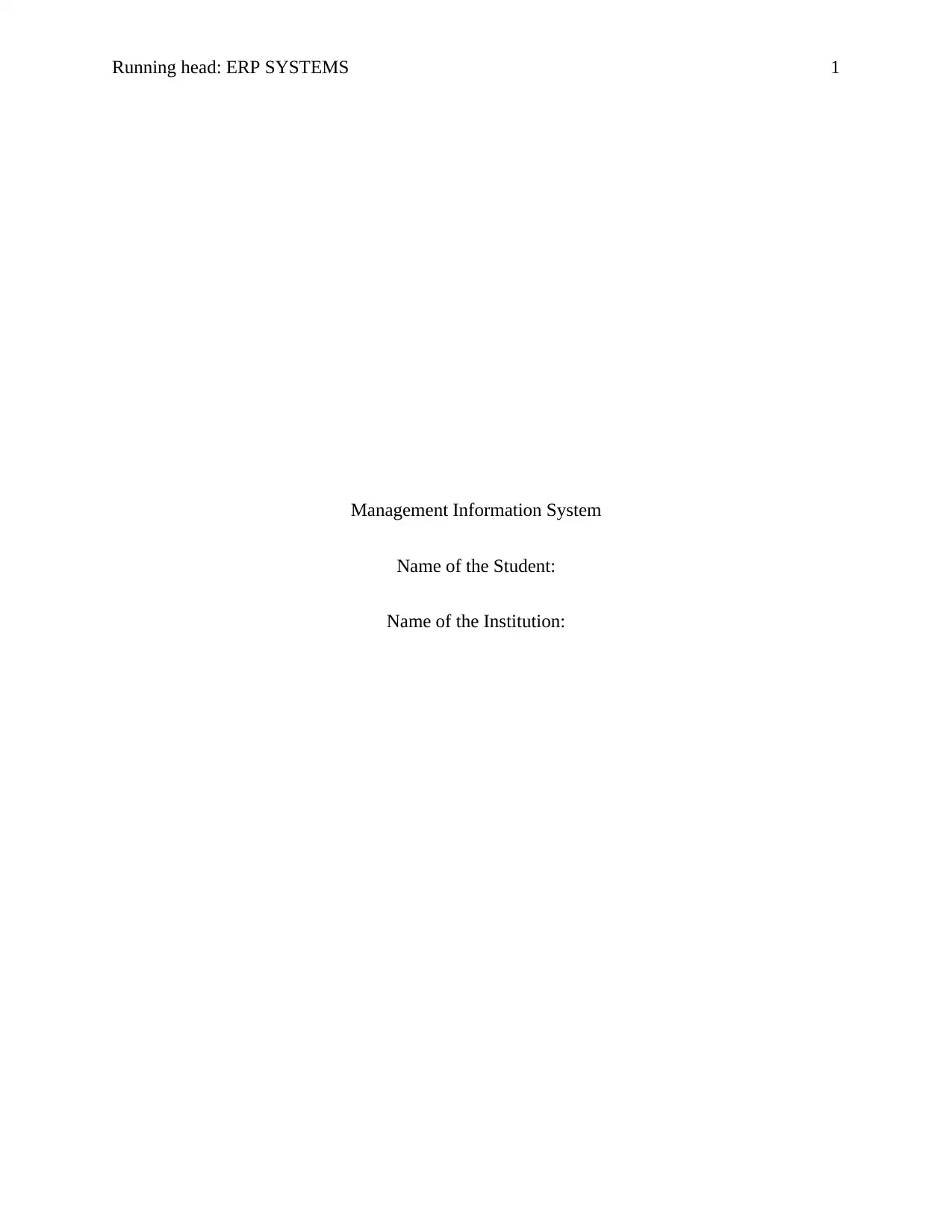
Running head: ERP SYSTEMS 1
Management Information System
Name of the Student:
Name of the Institution:
Management Information System
Name of the Student:
Name of the Institution:
Secure Best Marks with AI Grader
Need help grading? Try our AI Grader for instant feedback on your assignments.
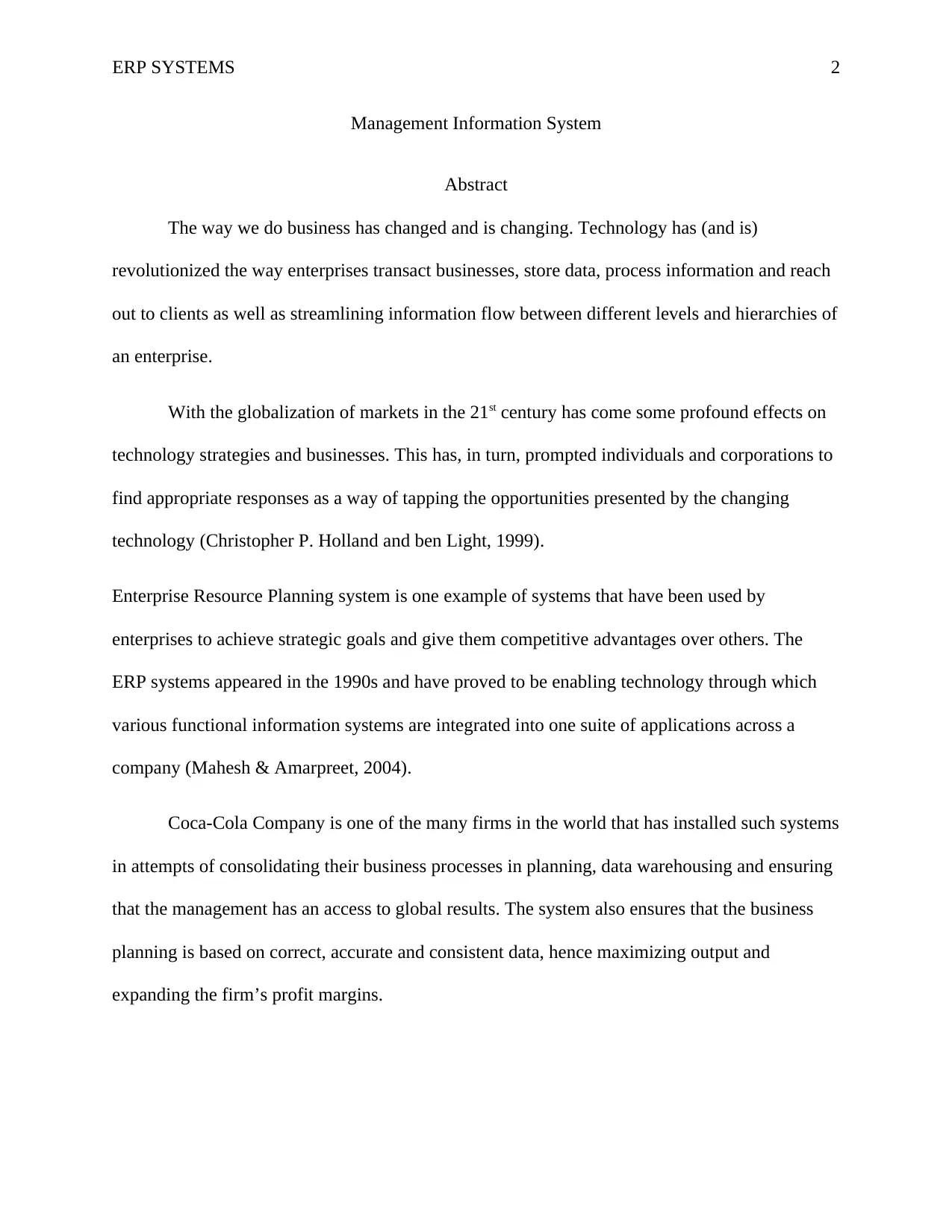
ERP SYSTEMS 2
Management Information System
Abstract
The way we do business has changed and is changing. Technology has (and is)
revolutionized the way enterprises transact businesses, store data, process information and reach
out to clients as well as streamlining information flow between different levels and hierarchies of
an enterprise.
With the globalization of markets in the 21st century has come some profound effects on
technology strategies and businesses. This has, in turn, prompted individuals and corporations to
find appropriate responses as a way of tapping the opportunities presented by the changing
technology (Christopher P. Holland and ben Light, 1999).
Enterprise Resource Planning system is one example of systems that have been used by
enterprises to achieve strategic goals and give them competitive advantages over others. The
ERP systems appeared in the 1990s and have proved to be enabling technology through which
various functional information systems are integrated into one suite of applications across a
company (Mahesh & Amarpreet, 2004).
Coca-Cola Company is one of the many firms in the world that has installed such systems
in attempts of consolidating their business processes in planning, data warehousing and ensuring
that the management has an access to global results. The system also ensures that the business
planning is based on correct, accurate and consistent data, hence maximizing output and
expanding the firm’s profit margins.
Management Information System
Abstract
The way we do business has changed and is changing. Technology has (and is)
revolutionized the way enterprises transact businesses, store data, process information and reach
out to clients as well as streamlining information flow between different levels and hierarchies of
an enterprise.
With the globalization of markets in the 21st century has come some profound effects on
technology strategies and businesses. This has, in turn, prompted individuals and corporations to
find appropriate responses as a way of tapping the opportunities presented by the changing
technology (Christopher P. Holland and ben Light, 1999).
Enterprise Resource Planning system is one example of systems that have been used by
enterprises to achieve strategic goals and give them competitive advantages over others. The
ERP systems appeared in the 1990s and have proved to be enabling technology through which
various functional information systems are integrated into one suite of applications across a
company (Mahesh & Amarpreet, 2004).
Coca-Cola Company is one of the many firms in the world that has installed such systems
in attempts of consolidating their business processes in planning, data warehousing and ensuring
that the management has an access to global results. The system also ensures that the business
planning is based on correct, accurate and consistent data, hence maximizing output and
expanding the firm’s profit margins.
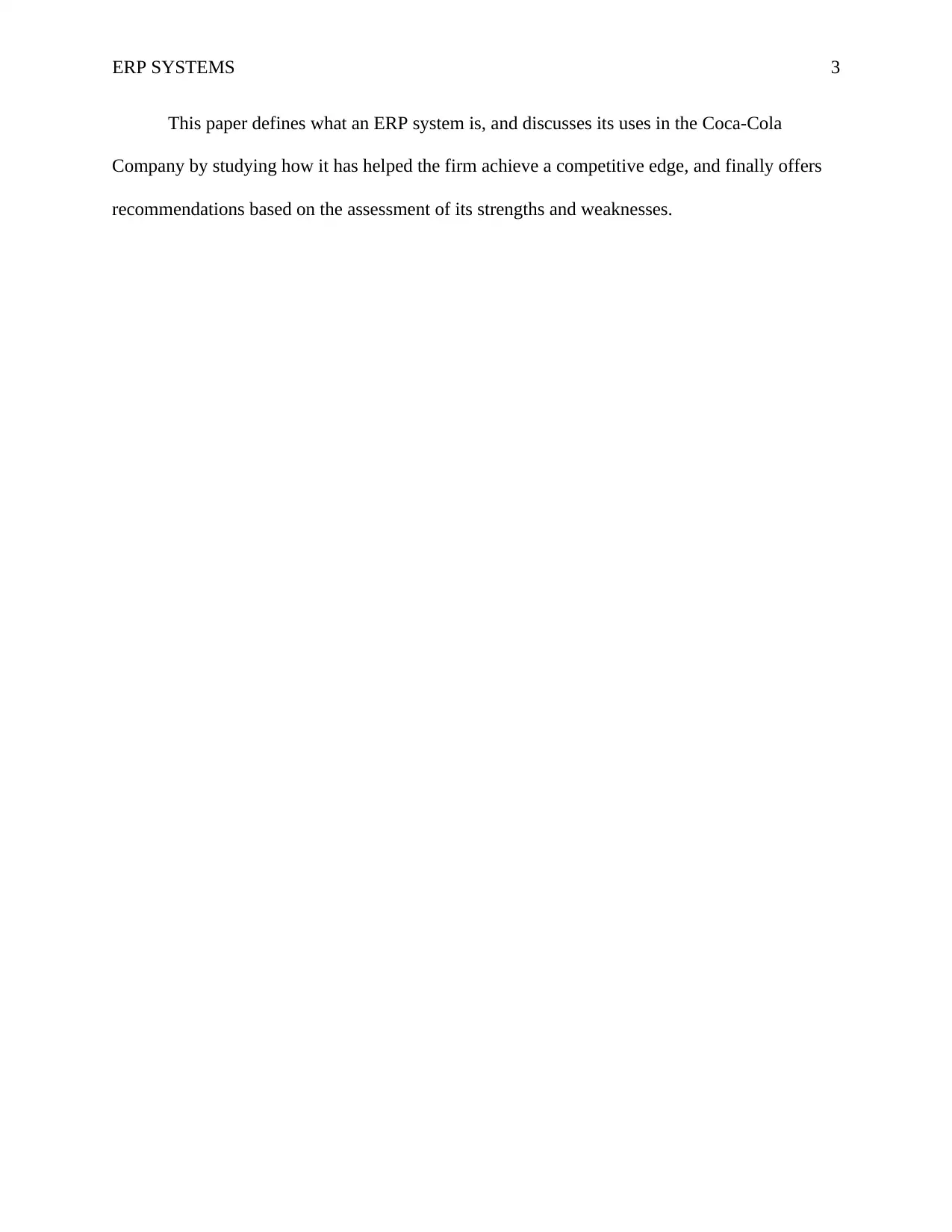
ERP SYSTEMS 3
This paper defines what an ERP system is, and discusses its uses in the Coca-Cola
Company by studying how it has helped the firm achieve a competitive edge, and finally offers
recommendations based on the assessment of its strengths and weaknesses.
This paper defines what an ERP system is, and discusses its uses in the Coca-Cola
Company by studying how it has helped the firm achieve a competitive edge, and finally offers
recommendations based on the assessment of its strengths and weaknesses.
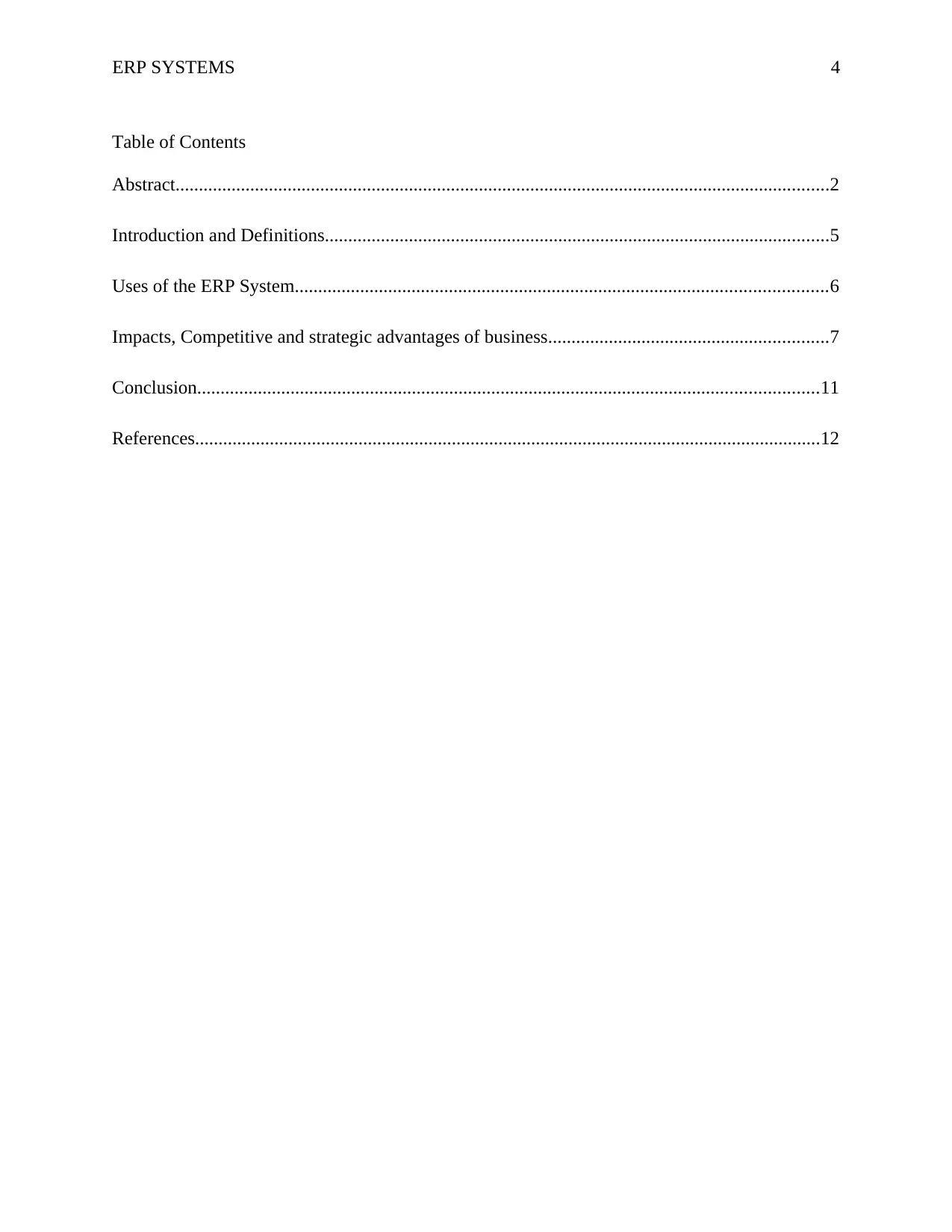
ERP SYSTEMS 4
Table of Contents
Abstract............................................................................................................................................2
Introduction and Definitions............................................................................................................5
Uses of the ERP System..................................................................................................................6
Impacts, Competitive and strategic advantages of business............................................................7
Conclusion.....................................................................................................................................11
References......................................................................................................................................12
Table of Contents
Abstract............................................................................................................................................2
Introduction and Definitions............................................................................................................5
Uses of the ERP System..................................................................................................................6
Impacts, Competitive and strategic advantages of business............................................................7
Conclusion.....................................................................................................................................11
References......................................................................................................................................12
Secure Best Marks with AI Grader
Need help grading? Try our AI Grader for instant feedback on your assignments.
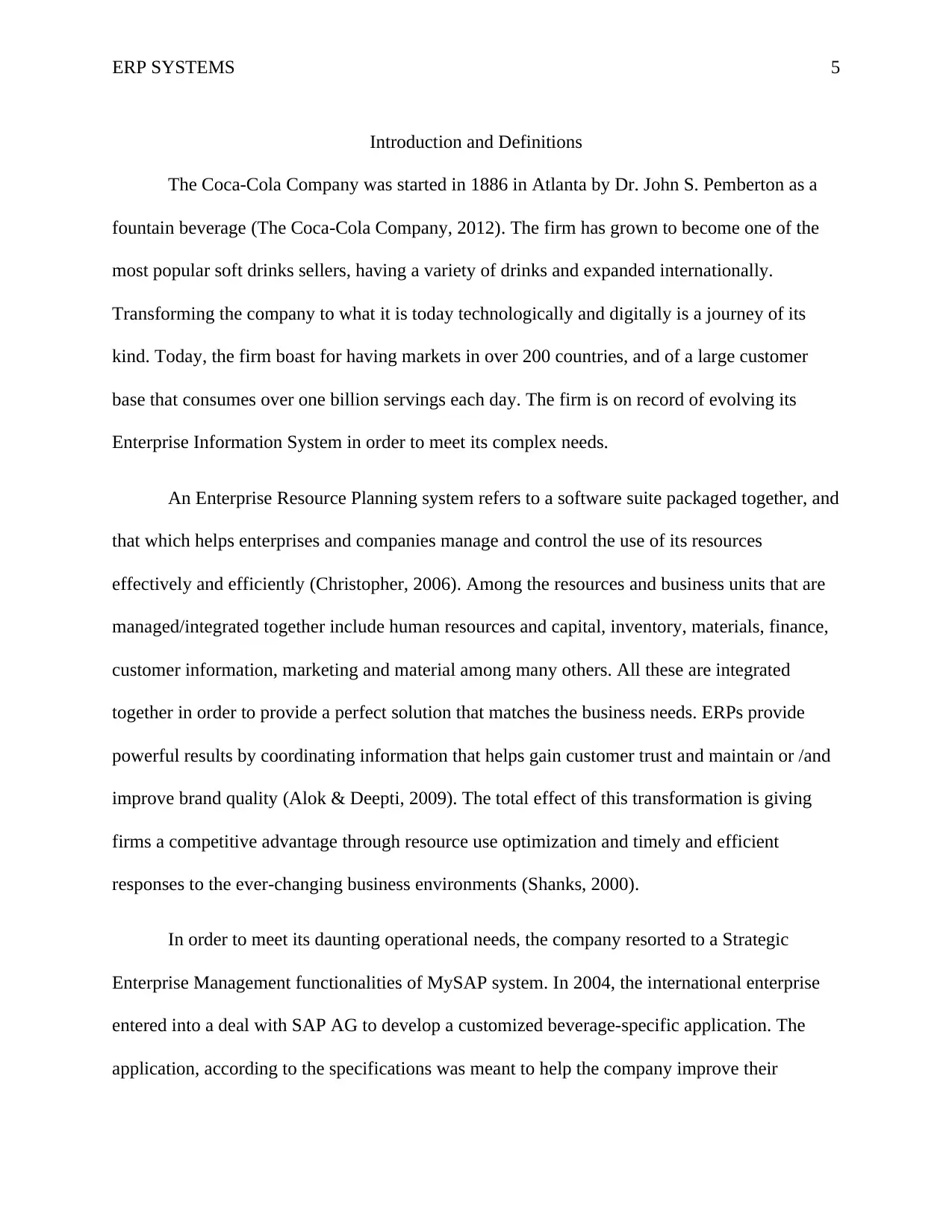
ERP SYSTEMS 5
Introduction and Definitions
The Coca-Cola Company was started in 1886 in Atlanta by Dr. John S. Pemberton as a
fountain beverage (The Coca-Cola Company, 2012). The firm has grown to become one of the
most popular soft drinks sellers, having a variety of drinks and expanded internationally.
Transforming the company to what it is today technologically and digitally is a journey of its
kind. Today, the firm boast for having markets in over 200 countries, and of a large customer
base that consumes over one billion servings each day. The firm is on record of evolving its
Enterprise Information System in order to meet its complex needs.
An Enterprise Resource Planning system refers to a software suite packaged together, and
that which helps enterprises and companies manage and control the use of its resources
effectively and efficiently (Christopher, 2006). Among the resources and business units that are
managed/integrated together include human resources and capital, inventory, materials, finance,
customer information, marketing and material among many others. All these are integrated
together in order to provide a perfect solution that matches the business needs. ERPs provide
powerful results by coordinating information that helps gain customer trust and maintain or /and
improve brand quality (Alok & Deepti, 2009). The total effect of this transformation is giving
firms a competitive advantage through resource use optimization and timely and efficient
responses to the ever-changing business environments (Shanks, 2000).
In order to meet its daunting operational needs, the company resorted to a Strategic
Enterprise Management functionalities of MySAP system. In 2004, the international enterprise
entered into a deal with SAP AG to develop a customized beverage-specific application. The
application, according to the specifications was meant to help the company improve their
Introduction and Definitions
The Coca-Cola Company was started in 1886 in Atlanta by Dr. John S. Pemberton as a
fountain beverage (The Coca-Cola Company, 2012). The firm has grown to become one of the
most popular soft drinks sellers, having a variety of drinks and expanded internationally.
Transforming the company to what it is today technologically and digitally is a journey of its
kind. Today, the firm boast for having markets in over 200 countries, and of a large customer
base that consumes over one billion servings each day. The firm is on record of evolving its
Enterprise Information System in order to meet its complex needs.
An Enterprise Resource Planning system refers to a software suite packaged together, and
that which helps enterprises and companies manage and control the use of its resources
effectively and efficiently (Christopher, 2006). Among the resources and business units that are
managed/integrated together include human resources and capital, inventory, materials, finance,
customer information, marketing and material among many others. All these are integrated
together in order to provide a perfect solution that matches the business needs. ERPs provide
powerful results by coordinating information that helps gain customer trust and maintain or /and
improve brand quality (Alok & Deepti, 2009). The total effect of this transformation is giving
firms a competitive advantage through resource use optimization and timely and efficient
responses to the ever-changing business environments (Shanks, 2000).
In order to meet its daunting operational needs, the company resorted to a Strategic
Enterprise Management functionalities of MySAP system. In 2004, the international enterprise
entered into a deal with SAP AG to develop a customized beverage-specific application. The
application, according to the specifications was meant to help the company improve their
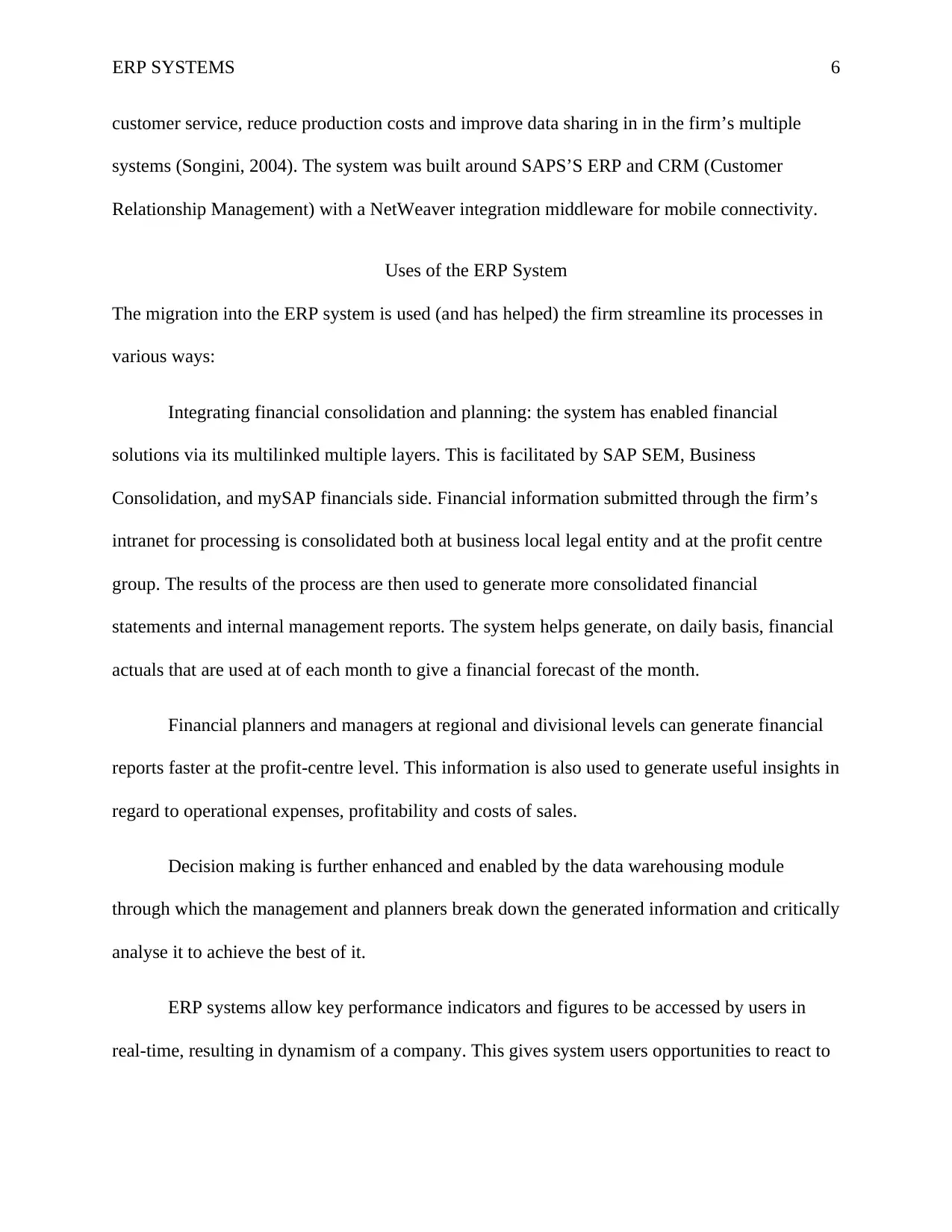
ERP SYSTEMS 6
customer service, reduce production costs and improve data sharing in in the firm’s multiple
systems (Songini, 2004). The system was built around SAPS’S ERP and CRM (Customer
Relationship Management) with a NetWeaver integration middleware for mobile connectivity.
Uses of the ERP System
The migration into the ERP system is used (and has helped) the firm streamline its processes in
various ways:
Integrating financial consolidation and planning: the system has enabled financial
solutions via its multilinked multiple layers. This is facilitated by SAP SEM, Business
Consolidation, and mySAP financials side. Financial information submitted through the firm’s
intranet for processing is consolidated both at business local legal entity and at the profit centre
group. The results of the process are then used to generate more consolidated financial
statements and internal management reports. The system helps generate, on daily basis, financial
actuals that are used at of each month to give a financial forecast of the month.
Financial planners and managers at regional and divisional levels can generate financial
reports faster at the profit-centre level. This information is also used to generate useful insights in
regard to operational expenses, profitability and costs of sales.
Decision making is further enhanced and enabled by the data warehousing module
through which the management and planners break down the generated information and critically
analyse it to achieve the best of it.
ERP systems allow key performance indicators and figures to be accessed by users in
real-time, resulting in dynamism of a company. This gives system users opportunities to react to
customer service, reduce production costs and improve data sharing in in the firm’s multiple
systems (Songini, 2004). The system was built around SAPS’S ERP and CRM (Customer
Relationship Management) with a NetWeaver integration middleware for mobile connectivity.
Uses of the ERP System
The migration into the ERP system is used (and has helped) the firm streamline its processes in
various ways:
Integrating financial consolidation and planning: the system has enabled financial
solutions via its multilinked multiple layers. This is facilitated by SAP SEM, Business
Consolidation, and mySAP financials side. Financial information submitted through the firm’s
intranet for processing is consolidated both at business local legal entity and at the profit centre
group. The results of the process are then used to generate more consolidated financial
statements and internal management reports. The system helps generate, on daily basis, financial
actuals that are used at of each month to give a financial forecast of the month.
Financial planners and managers at regional and divisional levels can generate financial
reports faster at the profit-centre level. This information is also used to generate useful insights in
regard to operational expenses, profitability and costs of sales.
Decision making is further enhanced and enabled by the data warehousing module
through which the management and planners break down the generated information and critically
analyse it to achieve the best of it.
ERP systems allow key performance indicators and figures to be accessed by users in
real-time, resulting in dynamism of a company. This gives system users opportunities to react to
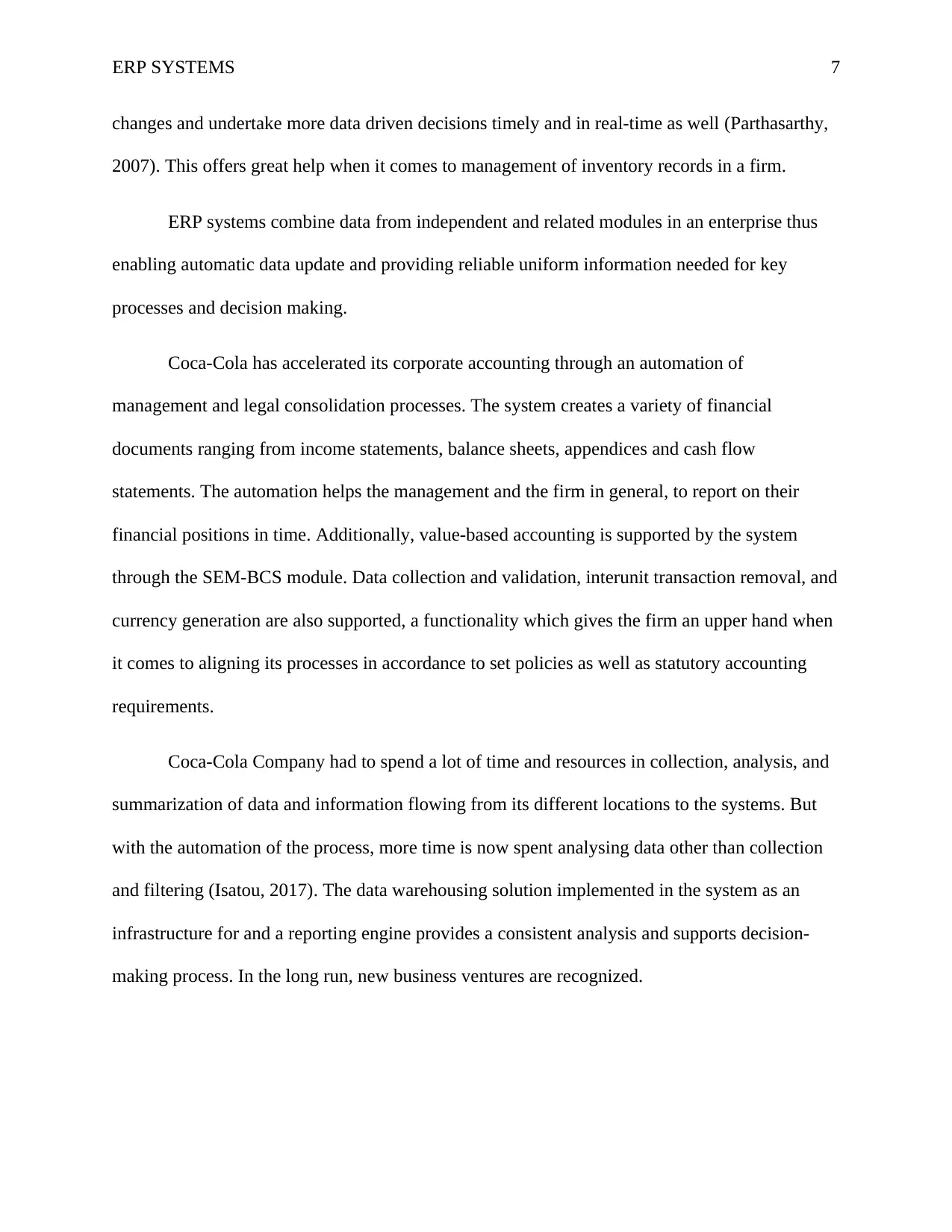
ERP SYSTEMS 7
changes and undertake more data driven decisions timely and in real-time as well (Parthasarthy,
2007). This offers great help when it comes to management of inventory records in a firm.
ERP systems combine data from independent and related modules in an enterprise thus
enabling automatic data update and providing reliable uniform information needed for key
processes and decision making.
Coca-Cola has accelerated its corporate accounting through an automation of
management and legal consolidation processes. The system creates a variety of financial
documents ranging from income statements, balance sheets, appendices and cash flow
statements. The automation helps the management and the firm in general, to report on their
financial positions in time. Additionally, value-based accounting is supported by the system
through the SEM-BCS module. Data collection and validation, interunit transaction removal, and
currency generation are also supported, a functionality which gives the firm an upper hand when
it comes to aligning its processes in accordance to set policies as well as statutory accounting
requirements.
Coca-Cola Company had to spend a lot of time and resources in collection, analysis, and
summarization of data and information flowing from its different locations to the systems. But
with the automation of the process, more time is now spent analysing data other than collection
and filtering (Isatou, 2017). The data warehousing solution implemented in the system as an
infrastructure for and a reporting engine provides a consistent analysis and supports decision-
making process. In the long run, new business ventures are recognized.
changes and undertake more data driven decisions timely and in real-time as well (Parthasarthy,
2007). This offers great help when it comes to management of inventory records in a firm.
ERP systems combine data from independent and related modules in an enterprise thus
enabling automatic data update and providing reliable uniform information needed for key
processes and decision making.
Coca-Cola has accelerated its corporate accounting through an automation of
management and legal consolidation processes. The system creates a variety of financial
documents ranging from income statements, balance sheets, appendices and cash flow
statements. The automation helps the management and the firm in general, to report on their
financial positions in time. Additionally, value-based accounting is supported by the system
through the SEM-BCS module. Data collection and validation, interunit transaction removal, and
currency generation are also supported, a functionality which gives the firm an upper hand when
it comes to aligning its processes in accordance to set policies as well as statutory accounting
requirements.
Coca-Cola Company had to spend a lot of time and resources in collection, analysis, and
summarization of data and information flowing from its different locations to the systems. But
with the automation of the process, more time is now spent analysing data other than collection
and filtering (Isatou, 2017). The data warehousing solution implemented in the system as an
infrastructure for and a reporting engine provides a consistent analysis and supports decision-
making process. In the long run, new business ventures are recognized.
Paraphrase This Document
Need a fresh take? Get an instant paraphrase of this document with our AI Paraphraser
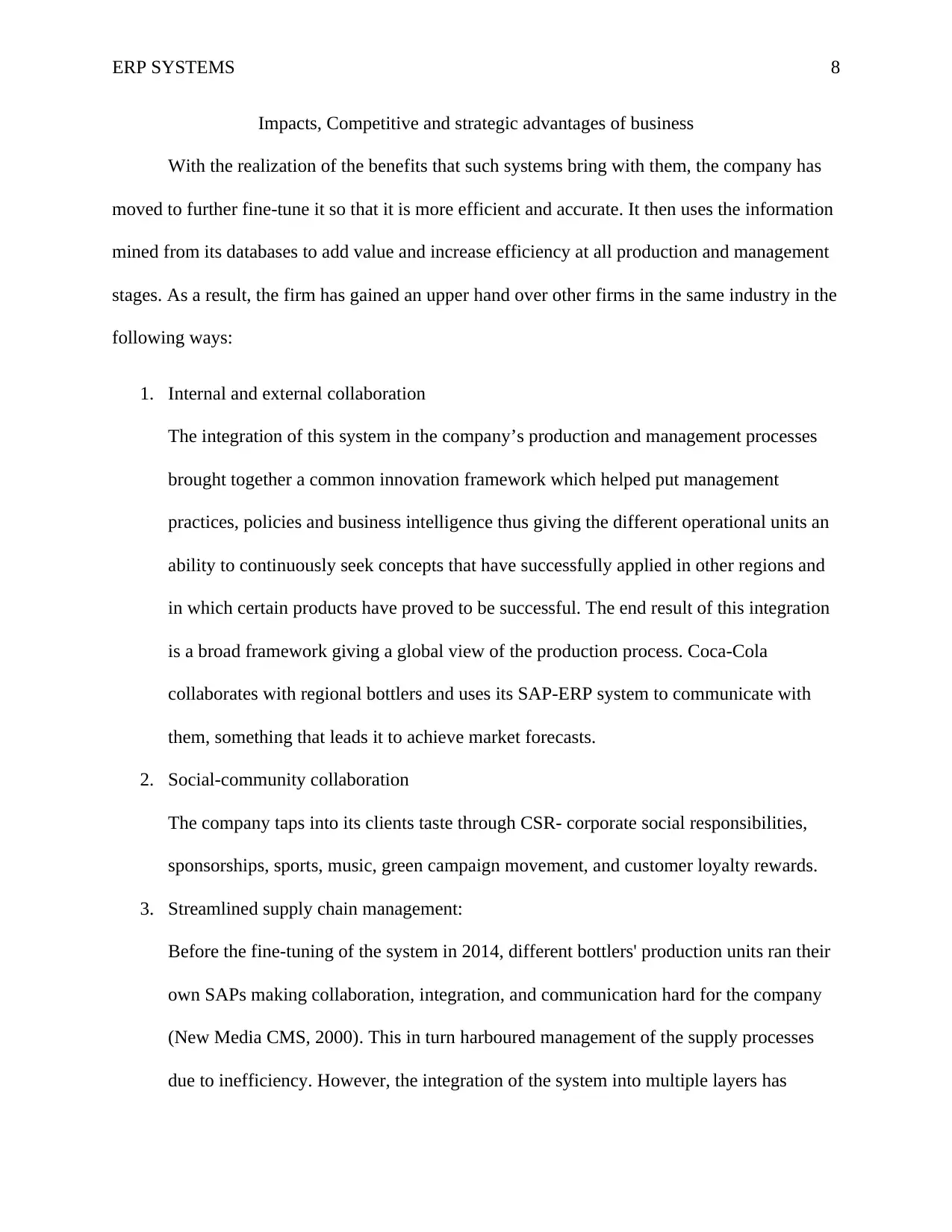
ERP SYSTEMS 8
Impacts, Competitive and strategic advantages of business
With the realization of the benefits that such systems bring with them, the company has
moved to further fine-tune it so that it is more efficient and accurate. It then uses the information
mined from its databases to add value and increase efficiency at all production and management
stages. As a result, the firm has gained an upper hand over other firms in the same industry in the
following ways:
1. Internal and external collaboration
The integration of this system in the company’s production and management processes
brought together a common innovation framework which helped put management
practices, policies and business intelligence thus giving the different operational units an
ability to continuously seek concepts that have successfully applied in other regions and
in which certain products have proved to be successful. The end result of this integration
is a broad framework giving a global view of the production process. Coca-Cola
collaborates with regional bottlers and uses its SAP-ERP system to communicate with
them, something that leads it to achieve market forecasts.
2. Social-community collaboration
The company taps into its clients taste through CSR- corporate social responsibilities,
sponsorships, sports, music, green campaign movement, and customer loyalty rewards.
3. Streamlined supply chain management:
Before the fine-tuning of the system in 2014, different bottlers' production units ran their
own SAPs making collaboration, integration, and communication hard for the company
(New Media CMS, 2000). This in turn harboured management of the supply processes
due to inefficiency. However, the integration of the system into multiple layers has
Impacts, Competitive and strategic advantages of business
With the realization of the benefits that such systems bring with them, the company has
moved to further fine-tune it so that it is more efficient and accurate. It then uses the information
mined from its databases to add value and increase efficiency at all production and management
stages. As a result, the firm has gained an upper hand over other firms in the same industry in the
following ways:
1. Internal and external collaboration
The integration of this system in the company’s production and management processes
brought together a common innovation framework which helped put management
practices, policies and business intelligence thus giving the different operational units an
ability to continuously seek concepts that have successfully applied in other regions and
in which certain products have proved to be successful. The end result of this integration
is a broad framework giving a global view of the production process. Coca-Cola
collaborates with regional bottlers and uses its SAP-ERP system to communicate with
them, something that leads it to achieve market forecasts.
2. Social-community collaboration
The company taps into its clients taste through CSR- corporate social responsibilities,
sponsorships, sports, music, green campaign movement, and customer loyalty rewards.
3. Streamlined supply chain management:
Before the fine-tuning of the system in 2014, different bottlers' production units ran their
own SAPs making collaboration, integration, and communication hard for the company
(New Media CMS, 2000). This in turn harboured management of the supply processes
due to inefficiency. However, the integration of the system into multiple layers has
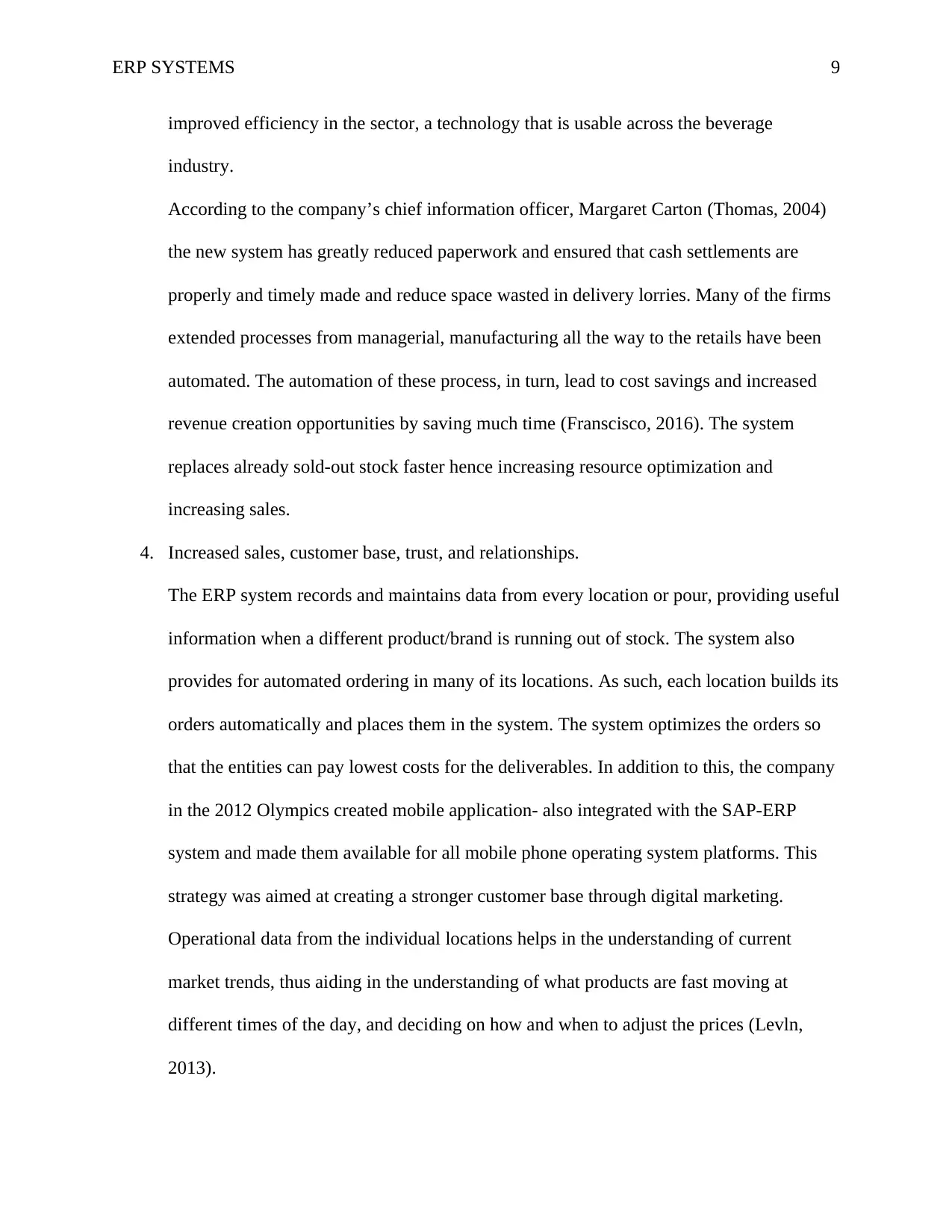
ERP SYSTEMS 9
improved efficiency in the sector, a technology that is usable across the beverage
industry.
According to the company’s chief information officer, Margaret Carton (Thomas, 2004)
the new system has greatly reduced paperwork and ensured that cash settlements are
properly and timely made and reduce space wasted in delivery lorries. Many of the firms
extended processes from managerial, manufacturing all the way to the retails have been
automated. The automation of these process, in turn, lead to cost savings and increased
revenue creation opportunities by saving much time (Franscisco, 2016). The system
replaces already sold-out stock faster hence increasing resource optimization and
increasing sales.
4. Increased sales, customer base, trust, and relationships.
The ERP system records and maintains data from every location or pour, providing useful
information when a different product/brand is running out of stock. The system also
provides for automated ordering in many of its locations. As such, each location builds its
orders automatically and places them in the system. The system optimizes the orders so
that the entities can pay lowest costs for the deliverables. In addition to this, the company
in the 2012 Olympics created mobile application- also integrated with the SAP-ERP
system and made them available for all mobile phone operating system platforms. This
strategy was aimed at creating a stronger customer base through digital marketing.
Operational data from the individual locations helps in the understanding of current
market trends, thus aiding in the understanding of what products are fast moving at
different times of the day, and deciding on how and when to adjust the prices (Levln,
2013).
improved efficiency in the sector, a technology that is usable across the beverage
industry.
According to the company’s chief information officer, Margaret Carton (Thomas, 2004)
the new system has greatly reduced paperwork and ensured that cash settlements are
properly and timely made and reduce space wasted in delivery lorries. Many of the firms
extended processes from managerial, manufacturing all the way to the retails have been
automated. The automation of these process, in turn, lead to cost savings and increased
revenue creation opportunities by saving much time (Franscisco, 2016). The system
replaces already sold-out stock faster hence increasing resource optimization and
increasing sales.
4. Increased sales, customer base, trust, and relationships.
The ERP system records and maintains data from every location or pour, providing useful
information when a different product/brand is running out of stock. The system also
provides for automated ordering in many of its locations. As such, each location builds its
orders automatically and places them in the system. The system optimizes the orders so
that the entities can pay lowest costs for the deliverables. In addition to this, the company
in the 2012 Olympics created mobile application- also integrated with the SAP-ERP
system and made them available for all mobile phone operating system platforms. This
strategy was aimed at creating a stronger customer base through digital marketing.
Operational data from the individual locations helps in the understanding of current
market trends, thus aiding in the understanding of what products are fast moving at
different times of the day, and deciding on how and when to adjust the prices (Levln,
2013).
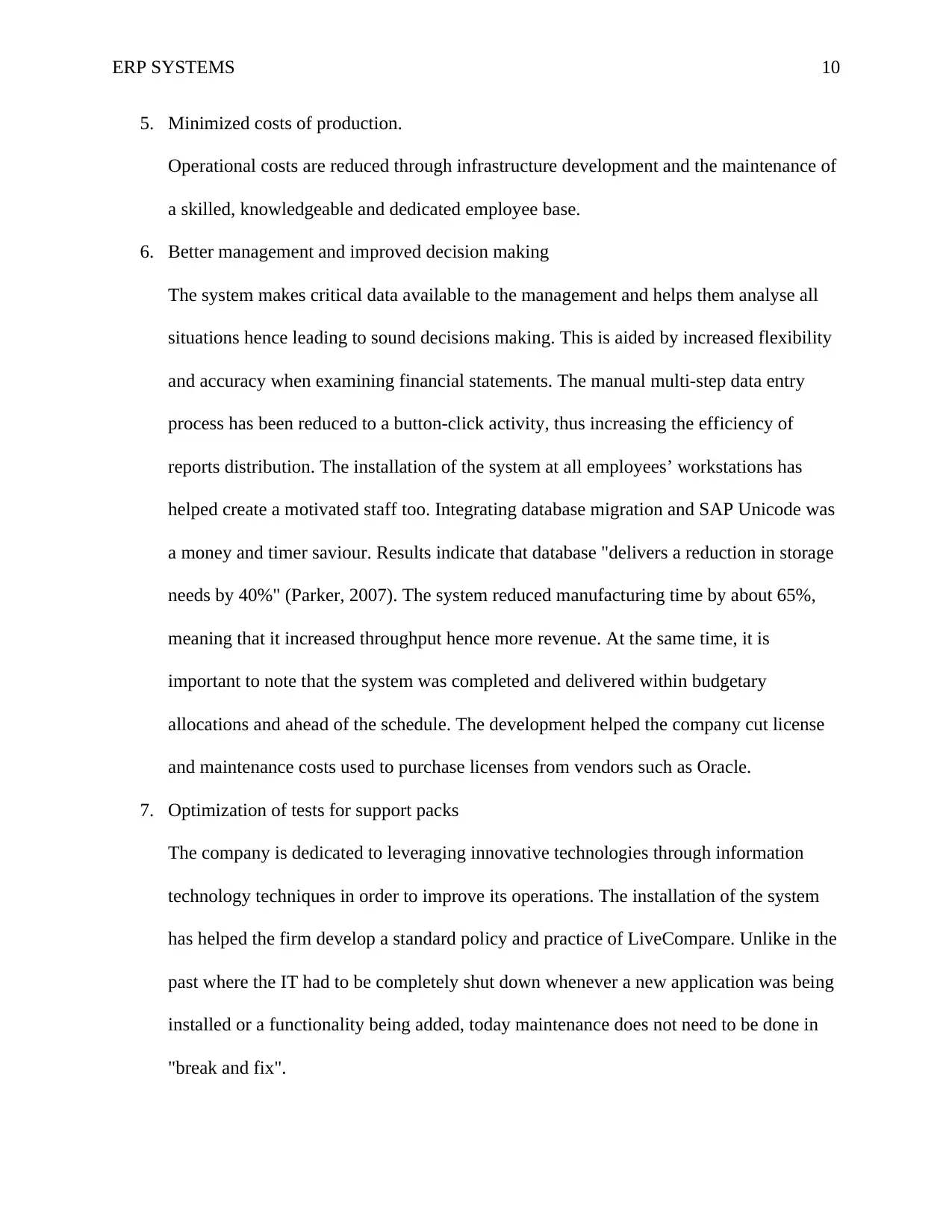
ERP SYSTEMS 10
5. Minimized costs of production.
Operational costs are reduced through infrastructure development and the maintenance of
a skilled, knowledgeable and dedicated employee base.
6. Better management and improved decision making
The system makes critical data available to the management and helps them analyse all
situations hence leading to sound decisions making. This is aided by increased flexibility
and accuracy when examining financial statements. The manual multi-step data entry
process has been reduced to a button-click activity, thus increasing the efficiency of
reports distribution. The installation of the system at all employees’ workstations has
helped create a motivated staff too. Integrating database migration and SAP Unicode was
a money and timer saviour. Results indicate that database "delivers a reduction in storage
needs by 40%" (Parker, 2007). The system reduced manufacturing time by about 65%,
meaning that it increased throughput hence more revenue. At the same time, it is
important to note that the system was completed and delivered within budgetary
allocations and ahead of the schedule. The development helped the company cut license
and maintenance costs used to purchase licenses from vendors such as Oracle.
7. Optimization of tests for support packs
The company is dedicated to leveraging innovative technologies through information
technology techniques in order to improve its operations. The installation of the system
has helped the firm develop a standard policy and practice of LiveCompare. Unlike in the
past where the IT had to be completely shut down whenever a new application was being
installed or a functionality being added, today maintenance does not need to be done in
"break and fix".
5. Minimized costs of production.
Operational costs are reduced through infrastructure development and the maintenance of
a skilled, knowledgeable and dedicated employee base.
6. Better management and improved decision making
The system makes critical data available to the management and helps them analyse all
situations hence leading to sound decisions making. This is aided by increased flexibility
and accuracy when examining financial statements. The manual multi-step data entry
process has been reduced to a button-click activity, thus increasing the efficiency of
reports distribution. The installation of the system at all employees’ workstations has
helped create a motivated staff too. Integrating database migration and SAP Unicode was
a money and timer saviour. Results indicate that database "delivers a reduction in storage
needs by 40%" (Parker, 2007). The system reduced manufacturing time by about 65%,
meaning that it increased throughput hence more revenue. At the same time, it is
important to note that the system was completed and delivered within budgetary
allocations and ahead of the schedule. The development helped the company cut license
and maintenance costs used to purchase licenses from vendors such as Oracle.
7. Optimization of tests for support packs
The company is dedicated to leveraging innovative technologies through information
technology techniques in order to improve its operations. The installation of the system
has helped the firm develop a standard policy and practice of LiveCompare. Unlike in the
past where the IT had to be completely shut down whenever a new application was being
installed or a functionality being added, today maintenance does not need to be done in
"break and fix".
Secure Best Marks with AI Grader
Need help grading? Try our AI Grader for instant feedback on your assignments.
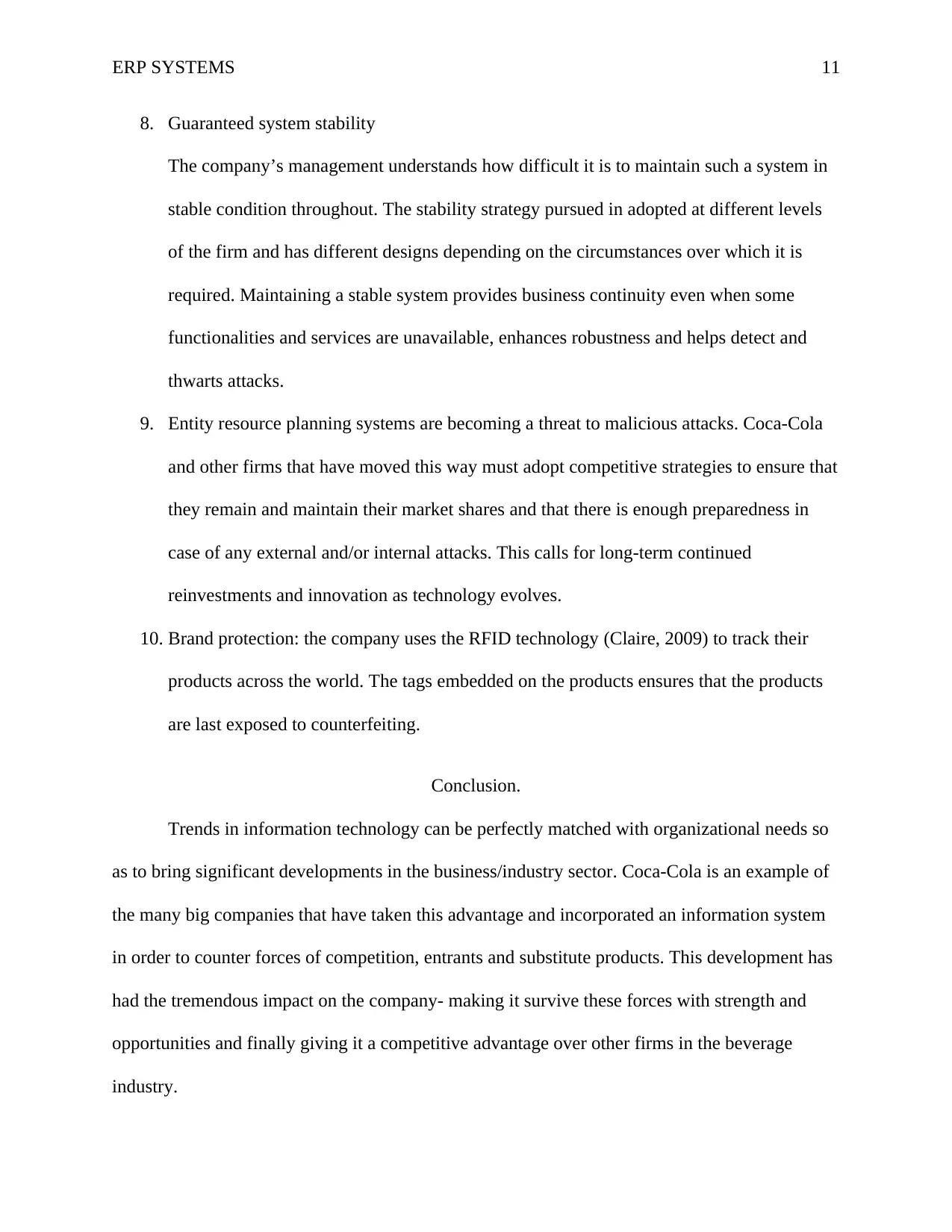
ERP SYSTEMS 11
8. Guaranteed system stability
The company’s management understands how difficult it is to maintain such a system in
stable condition throughout. The stability strategy pursued in adopted at different levels
of the firm and has different designs depending on the circumstances over which it is
required. Maintaining a stable system provides business continuity even when some
functionalities and services are unavailable, enhances robustness and helps detect and
thwarts attacks.
9. Entity resource planning systems are becoming a threat to malicious attacks. Coca-Cola
and other firms that have moved this way must adopt competitive strategies to ensure that
they remain and maintain their market shares and that there is enough preparedness in
case of any external and/or internal attacks. This calls for long-term continued
reinvestments and innovation as technology evolves.
10. Brand protection: the company uses the RFID technology (Claire, 2009) to track their
products across the world. The tags embedded on the products ensures that the products
are last exposed to counterfeiting.
Conclusion.
Trends in information technology can be perfectly matched with organizational needs so
as to bring significant developments in the business/industry sector. Coca-Cola is an example of
the many big companies that have taken this advantage and incorporated an information system
in order to counter forces of competition, entrants and substitute products. This development has
had the tremendous impact on the company- making it survive these forces with strength and
opportunities and finally giving it a competitive advantage over other firms in the beverage
industry.
8. Guaranteed system stability
The company’s management understands how difficult it is to maintain such a system in
stable condition throughout. The stability strategy pursued in adopted at different levels
of the firm and has different designs depending on the circumstances over which it is
required. Maintaining a stable system provides business continuity even when some
functionalities and services are unavailable, enhances robustness and helps detect and
thwarts attacks.
9. Entity resource planning systems are becoming a threat to malicious attacks. Coca-Cola
and other firms that have moved this way must adopt competitive strategies to ensure that
they remain and maintain their market shares and that there is enough preparedness in
case of any external and/or internal attacks. This calls for long-term continued
reinvestments and innovation as technology evolves.
10. Brand protection: the company uses the RFID technology (Claire, 2009) to track their
products across the world. The tags embedded on the products ensures that the products
are last exposed to counterfeiting.
Conclusion.
Trends in information technology can be perfectly matched with organizational needs so
as to bring significant developments in the business/industry sector. Coca-Cola is an example of
the many big companies that have taken this advantage and incorporated an information system
in order to counter forces of competition, entrants and substitute products. This development has
had the tremendous impact on the company- making it survive these forces with strength and
opportunities and finally giving it a competitive advantage over other firms in the beverage
industry.
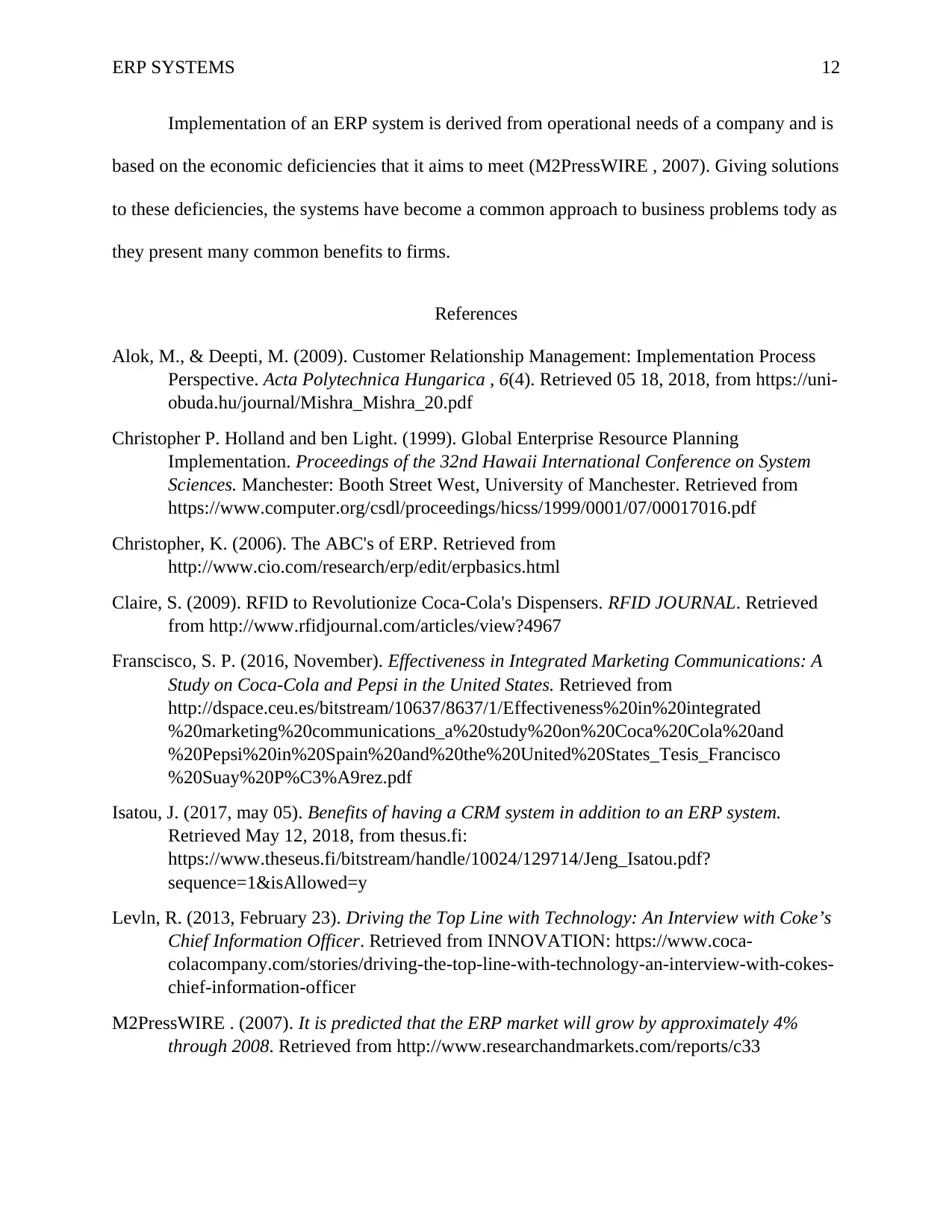
ERP SYSTEMS 12
Implementation of an ERP system is derived from operational needs of a company and is
based on the economic deficiencies that it aims to meet (M2PressWIRE , 2007). Giving solutions
to these deficiencies, the systems have become a common approach to business problems tody as
they present many common benefits to firms.
References
Alok, M., & Deepti, M. (2009). Customer Relationship Management: Implementation Process
Perspective. Acta Polytechnica Hungarica , 6(4). Retrieved 05 18, 2018, from https://uni-
obuda.hu/journal/Mishra_Mishra_20.pdf
Christopher P. Holland and ben Light. (1999). Global Enterprise Resource Planning
Implementation. Proceedings of the 32nd Hawaii International Conference on System
Sciences. Manchester: Booth Street West, University of Manchester. Retrieved from
https://www.computer.org/csdl/proceedings/hicss/1999/0001/07/00017016.pdf
Christopher, K. (2006). The ABC's of ERP. Retrieved from
http://www.cio.com/research/erp/edit/erpbasics.html
Claire, S. (2009). RFID to Revolutionize Coca-Cola's Dispensers. RFID JOURNAL. Retrieved
from http://www.rfidjournal.com/articles/view?4967
Franscisco, S. P. (2016, November). Effectiveness in Integrated Marketing Communications: A
Study on Coca-Cola and Pepsi in the United States. Retrieved from
http://dspace.ceu.es/bitstream/10637/8637/1/Effectiveness%20in%20integrated
%20marketing%20communications_a%20study%20on%20Coca%20Cola%20and
%20Pepsi%20in%20Spain%20and%20the%20United%20States_Tesis_Francisco
%20Suay%20P%C3%A9rez.pdf
Isatou, J. (2017, may 05). Benefits of having a CRM system in addition to an ERP system.
Retrieved May 12, 2018, from thesus.fi:
https://www.theseus.fi/bitstream/handle/10024/129714/Jeng_Isatou.pdf?
sequence=1&isAllowed=y
Levln, R. (2013, February 23). Driving the Top Line with Technology: An Interview with Coke’s
Chief Information Officer. Retrieved from INNOVATION: https://www.coca-
colacompany.com/stories/driving-the-top-line-with-technology-an-interview-with-cokes-
chief-information-officer
M2PressWIRE . (2007). It is predicted that the ERP market will grow by approximately 4%
through 2008. Retrieved from http://www.researchandmarkets.com/reports/c33
Implementation of an ERP system is derived from operational needs of a company and is
based on the economic deficiencies that it aims to meet (M2PressWIRE , 2007). Giving solutions
to these deficiencies, the systems have become a common approach to business problems tody as
they present many common benefits to firms.
References
Alok, M., & Deepti, M. (2009). Customer Relationship Management: Implementation Process
Perspective. Acta Polytechnica Hungarica , 6(4). Retrieved 05 18, 2018, from https://uni-
obuda.hu/journal/Mishra_Mishra_20.pdf
Christopher P. Holland and ben Light. (1999). Global Enterprise Resource Planning
Implementation. Proceedings of the 32nd Hawaii International Conference on System
Sciences. Manchester: Booth Street West, University of Manchester. Retrieved from
https://www.computer.org/csdl/proceedings/hicss/1999/0001/07/00017016.pdf
Christopher, K. (2006). The ABC's of ERP. Retrieved from
http://www.cio.com/research/erp/edit/erpbasics.html
Claire, S. (2009). RFID to Revolutionize Coca-Cola's Dispensers. RFID JOURNAL. Retrieved
from http://www.rfidjournal.com/articles/view?4967
Franscisco, S. P. (2016, November). Effectiveness in Integrated Marketing Communications: A
Study on Coca-Cola and Pepsi in the United States. Retrieved from
http://dspace.ceu.es/bitstream/10637/8637/1/Effectiveness%20in%20integrated
%20marketing%20communications_a%20study%20on%20Coca%20Cola%20and
%20Pepsi%20in%20Spain%20and%20the%20United%20States_Tesis_Francisco
%20Suay%20P%C3%A9rez.pdf
Isatou, J. (2017, may 05). Benefits of having a CRM system in addition to an ERP system.
Retrieved May 12, 2018, from thesus.fi:
https://www.theseus.fi/bitstream/handle/10024/129714/Jeng_Isatou.pdf?
sequence=1&isAllowed=y
Levln, R. (2013, February 23). Driving the Top Line with Technology: An Interview with Coke’s
Chief Information Officer. Retrieved from INNOVATION: https://www.coca-
colacompany.com/stories/driving-the-top-line-with-technology-an-interview-with-cokes-
chief-information-officer
M2PressWIRE . (2007). It is predicted that the ERP market will grow by approximately 4%
through 2008. Retrieved from http://www.researchandmarkets.com/reports/c33
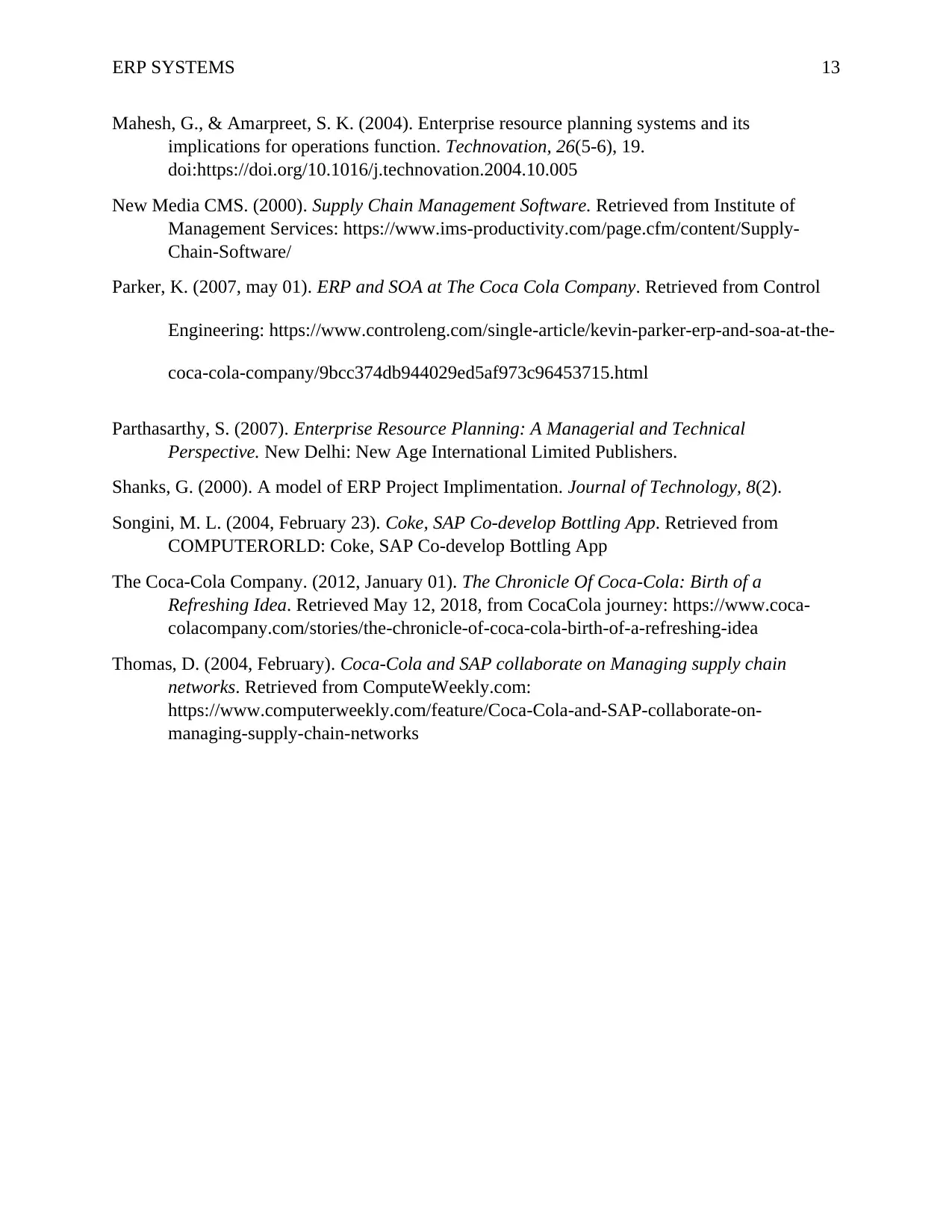
ERP SYSTEMS 13
Mahesh, G., & Amarpreet, S. K. (2004). Enterprise resource planning systems and its
implications for operations function. Technovation, 26(5-6), 19.
doi:https://doi.org/10.1016/j.technovation.2004.10.005
New Media CMS. (2000). Supply Chain Management Software. Retrieved from Institute of
Management Services: https://www.ims-productivity.com/page.cfm/content/Supply-
Chain-Software/
Parker, K. (2007, may 01). ERP and SOA at The Coca Cola Company. Retrieved from Control
Engineering: https://www.controleng.com/single-article/kevin-parker-erp-and-soa-at-the-
coca-cola-company/9bcc374db944029ed5af973c96453715.html
Parthasarthy, S. (2007). Enterprise Resource Planning: A Managerial and Technical
Perspective. New Delhi: New Age International Limited Publishers.
Shanks, G. (2000). A model of ERP Project Implimentation. Journal of Technology, 8(2).
Songini, M. L. (2004, February 23). Coke, SAP Co-develop Bottling App. Retrieved from
COMPUTERORLD: Coke, SAP Co-develop Bottling App
The Coca-Cola Company. (2012, January 01). The Chronicle Of Coca-Cola: Birth of a
Refreshing Idea. Retrieved May 12, 2018, from CocaCola journey: https://www.coca-
colacompany.com/stories/the-chronicle-of-coca-cola-birth-of-a-refreshing-idea
Thomas, D. (2004, February). Coca-Cola and SAP collaborate on Managing supply chain
networks. Retrieved from ComputeWeekly.com:
https://www.computerweekly.com/feature/Coca-Cola-and-SAP-collaborate-on-
managing-supply-chain-networks
Mahesh, G., & Amarpreet, S. K. (2004). Enterprise resource planning systems and its
implications for operations function. Technovation, 26(5-6), 19.
doi:https://doi.org/10.1016/j.technovation.2004.10.005
New Media CMS. (2000). Supply Chain Management Software. Retrieved from Institute of
Management Services: https://www.ims-productivity.com/page.cfm/content/Supply-
Chain-Software/
Parker, K. (2007, may 01). ERP and SOA at The Coca Cola Company. Retrieved from Control
Engineering: https://www.controleng.com/single-article/kevin-parker-erp-and-soa-at-the-
coca-cola-company/9bcc374db944029ed5af973c96453715.html
Parthasarthy, S. (2007). Enterprise Resource Planning: A Managerial and Technical
Perspective. New Delhi: New Age International Limited Publishers.
Shanks, G. (2000). A model of ERP Project Implimentation. Journal of Technology, 8(2).
Songini, M. L. (2004, February 23). Coke, SAP Co-develop Bottling App. Retrieved from
COMPUTERORLD: Coke, SAP Co-develop Bottling App
The Coca-Cola Company. (2012, January 01). The Chronicle Of Coca-Cola: Birth of a
Refreshing Idea. Retrieved May 12, 2018, from CocaCola journey: https://www.coca-
colacompany.com/stories/the-chronicle-of-coca-cola-birth-of-a-refreshing-idea
Thomas, D. (2004, February). Coca-Cola and SAP collaborate on Managing supply chain
networks. Retrieved from ComputeWeekly.com:
https://www.computerweekly.com/feature/Coca-Cola-and-SAP-collaborate-on-
managing-supply-chain-networks
1 out of 13
Related Documents
Your All-in-One AI-Powered Toolkit for Academic Success.
+13062052269
info@desklib.com
Available 24*7 on WhatsApp / Email
![[object Object]](/_next/static/media/star-bottom.7253800d.svg)
Unlock your academic potential
© 2024 | Zucol Services PVT LTD | All rights reserved.





